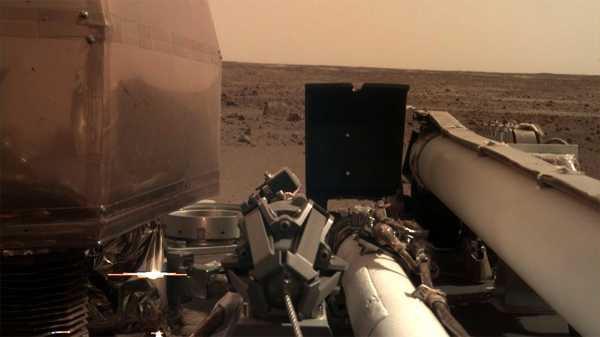
Last week, after a harrowing 6.5-minute self-guided descent, NASA’s InSight lander touched down on Mars to begin its two-year investigation of Martian geology.
And today, we learned the lander has sent back what, according to NASA is, the first-ever audio dispatch from Mars: a recording of the sound of the wind on the Martian surface. So far, we’ve only gotten back images of what Mars looks like from the robots that have landed there. So this is a new way to experience the planet and imagine what it might be like to be there.
Here, listen for yourself. You can hear winds of around 10 to 15 mph brush against the spacecraft.
The noise in the video above was picked up by the craft’s air pressure sensor, by its seismometer, and via the solar panels that jiggle in the wind. So it’s not, necessarily, the sound you’d hear via a microphone.
Most of the noises are very low in pitch, making them hard to hear without good headphones or a subwoofer. Other instances of the recording are sped up, so you can more clearly hear the breeze.
InSight stands for “Interior Exploration using Seismic Investigations, Geodesy and Heat Transport,” and it’s there to study Mars’s core. It’s basically a robot geologist. Using extremely sensitive instruments, it will literally be able to feel the planet’s seismic activity and temperature, and record, for the first time, “Marsquakes.”
“Each Marsquake would be like a flashbulb that illuminates the structure of the planet’s interior,” NASA explains. “By studying how seismic waves pass through the different layers of the planet (the crust, mantle and core), scientists can deduce the depths of these layers and what they’re made of. In this way, seismology is like taking an X-ray of the interior of Mars.”
InSight will also be taking the temperature of Mars; the Heat Flow and Physical Properties Probe will hammer 16 feet down into the surface. The instrument will be able to determine how heat flows from Mars’s core to its surface, and help scientists understand if the cores of Earth and Mars formed in a similar way.
This is all important to study because scientists want to better understand how rocky planets like Mars, Earth, and Venus form. Underneath the surface of Earth is a molten-hot mantle upon which our landmasses (tectonic plates) float. Plate tectonics are responsible for much of the geologic activity on Earth, generating the energy for earthquakes and volcanoes. But Mars doesn’t have tectonics that are active like Earth’s.
We’ll get better audio from Mars in the years to come. The Mars 2020 rover — planned to launch, in, well, 2020 — will have microphones on board, NASA reports.
Sourse: vox.com






